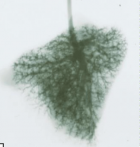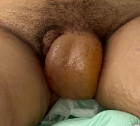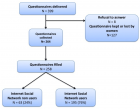Table of Contents
Uterine precursor lesions in patients with incidental nodal lymphangioleiomyomatosis: A report of 4 cases
Published on: 14th December, 2020
OCLC Number/Unique Identifier: 8514665038
Uterine sections from 6 patients with incidental nodal lymphangioleiomyomatosis (LAM) were examined for LAM lesions by screening these sections with cathepsin K immunohistochemistry (IHC) stains. The hysterectomy specimens were all concurrent with the lymph node dissections in which the nodal LAM was discovered. In 4 of 6 patients microscopic lesions of pre-LAM were identified and confirmed by IHC staining for HMB-45 and beta-catenin. All lesions were grossly inapparent and also inapparent by routine hematoxylin and eosin stains. Three variants of pre-LAM lesions were identified. None of the pre-LAM lesions had an associated lymphatic proliferation. It is proposed that these pre-LAM lesions gave rise to the incidental nodal LAM lesions. Furthermore, it is suggested that the absence of an associated lymphatic proliferation associated with these lesions may be a factor in the attenuated potential for spread and the only rare association of these nodal lesions with pulmonary LAM.
Emergency care sick palliative and problems oncology in emergency department during the COVID-19 pandemic
Published on: 30th September, 2020
OCLC Number/Unique Identifier: 8873202033
Emergency medical care in palliative patients during the COVID-19 pandemic, it is important to provide a consistent treatment for stable patients that should be consistent with the goals and benefits, the perspective of these patients, but avoiding palliative patients with a poor prognosis that is unlikely to survive. Cancer is the second leading cause of death in the world around 8.8 million deaths a year. Worldwide, about 7-10 million patients are diagnosed with cancer each year, recently there has been a significant increase in the number of cases diagnosed with cancer. About 70% of cancer deaths are in low- and middle-income countries. The goals of emergency medical care based on the criteria of BLS and ACLS, that is should be done “Do not do resuscitation, do not intubate but continue medical treatment excluding endotracheal intubation without prospects for the patient, but offering BLS only treatment concentrated symptomatic. ED is often the only place that can provide the necessary medical interventions (e.g., intravenous fluids or pain management medications. Medications as well as immediate access to advanced diagnostic tests when needed such as CT, RM and other diagnostic and treatment procedures.
Detection of IDH mutations in cerebrospinal fluid: A discussion of liquid biopsy in neuropathology
Published on: 17th September, 2020
OCLC Number/Unique Identifier: 8873201615
Isocitrate dehydrogenase (IDH) mutations are a common event in secondary glioblastoma multiforme and lower-grade adult infiltrative astrocytomas and independently confer a better prognosis [1,2]. These are highly conserved mutations during glioma progression and thus also a useful diagnostic marker amenable to modern molecular sequencing methods. These mutations can even be detected in sites distant from the primary tumour. We use an illustrative case of a patient with radiologically suspected recurrent astrocytoma and negative histology, but positive IDH-mutated tumour DNA detected within CSF. Our results demonstrated the usefulness of liquid biopsy for recurrent glioma within the context of equivocal or negative histopathological results, whilst also showing the ability to detect a de-novo IDH-2 mutation not present in the previous resection. Building on this ‘proof-of-concept’ result, we also take the opportunity to briefly review the current literature describing the various liquid biopsy substrates available to diagnose infiltrative gliomas, namely the study of circulating tumour DNA, circulating tumour cells, and extracellular vesicles. We outline the current challenges and prospects of liquid biopsies in these tumours and suggest that more studies are required to overcome these challenges and harness the potential benefits of liquid biopsies in guiding our management of gliomas
Molecular analysis of immunoglobulins related to Salmonella typhi in pediatric patients
Published on: 24th April, 2020
OCLC Number/Unique Identifier: 8591037429
Typhoid fever is a systemic infection caused by Salmonella enterica serotype typhi. It is of major concern in tropical regions of the world. Highest episodes of typhoid fever occur in Asia i.e.93%. Early diagnosis of the disease is mandatory to lower the mortality rate associated with it as well as to prevent the emergence of antimicrobial drug resistance by Salmonella typhi. Research work was conducted in Immunology Department of the Children’s Hospital, Lahore for the period of one year including a total of 60 patients suspected of having typhoid fever. Serum samples of these patients were tested for typhidot IgG and IgM antibodies as well as for the antibodies against TO and TH antigens using Widal test. Of the total 60 patients, 10 (16.7%) were positive for both typhidot IgG and IgM, 16 (26.7%) were positive for typhidot IgM, 3 (5%) were Positive for typhidot IgG and 31 (51.66%) were negative for both typhidot IgG and IgM. Reading the results of Widal test, 8 (13.33%) were positive for Widal TO and TH antigens, 3 (5%) were positive for Widal TO antigen, 19 (31.7%) were positive for Widal TH antigen and 30 (50%) were negative for Widal TO and TH antigens. IgM is positive at the early stage of acute typhoid fever, IgM along with IgG positive means the middle stage of acute illness. The detection of only IgG cannot discriminate between acute and convalescent phases as it can stay in the serum for at least 2 years or more. The typhidot test is much helpful for the rapid diagnosis of typhoid fever as compared to Widal test which is still being used in some set ups in poor countries, although has become mostly obsolete. By testing the rise of IgM and IgG antibodies against Salmonella typhi, we can detect the infection at early and late stages, respectively

HSPI: We're glad you're here. Please click "create a new Query" if you are a new visitor to our website and need further information from us.
If you are already a member of our network and need to keep track of any developments regarding a question you have already submitted, click "take me to my Query."


















































































































































